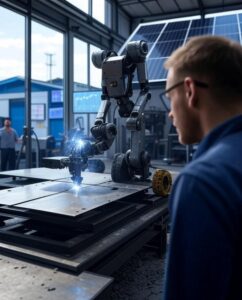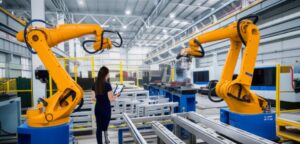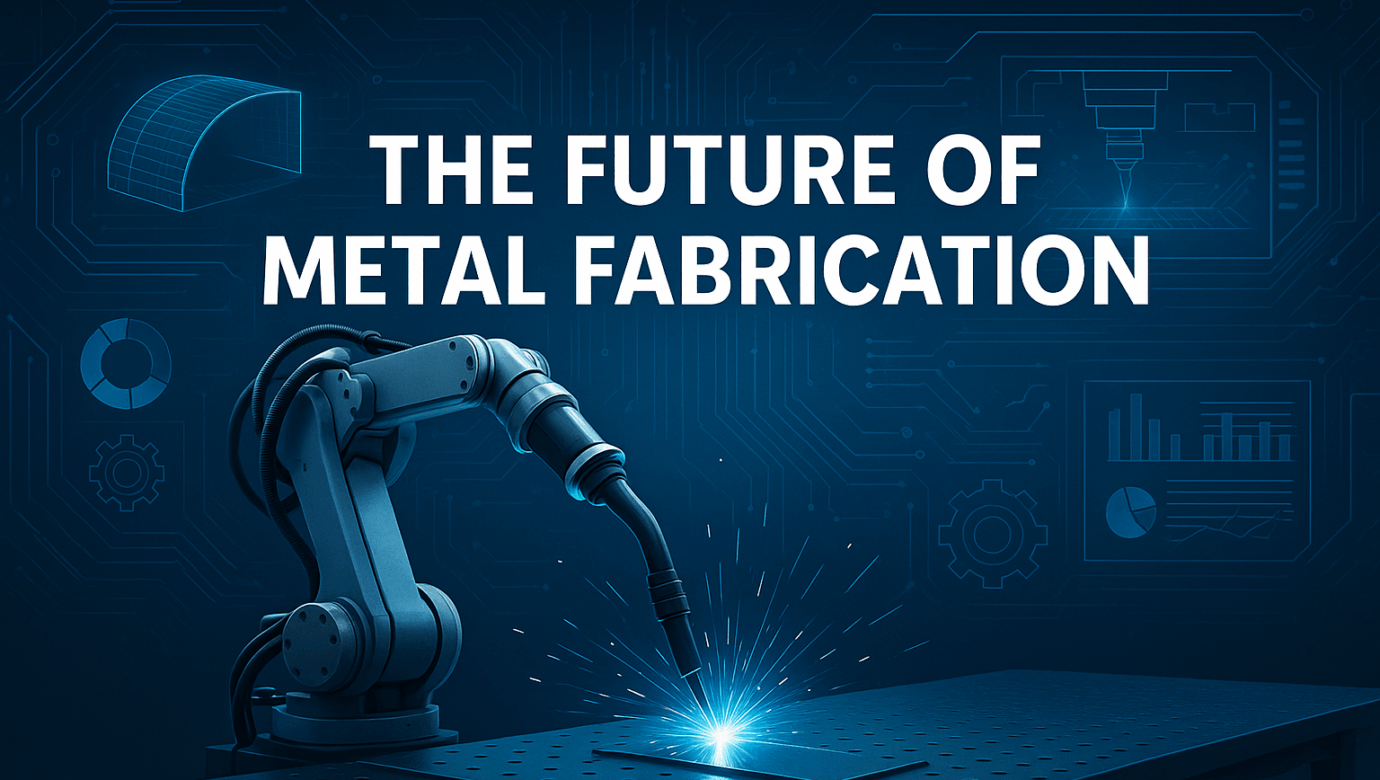The Future of Metal Fabrication Is Already Here – Are You Ready to Keep Up?
Not long ago, the idea of robots welding parts together or AI-driven systems adjusting tolerances in real-time felt like science fiction. Today, it’s becoming standard practice in the workshops of forward-thinking companies around the world. The metal fabrication industry has entered a new era—faster, smarter, and more connected than ever before.
In the heart of the GCC, where megaprojects rise from desert sands and timelines are tighter than ever, Morshedi Building Metal Products Manufacturing LLC is aligning itself with this transformation. With innovation at the core of its vision, Morshedi is actively exploring how to adopt emerging technologies and sustainable practices.
But what exactly does the future of metal fabrication look like? Which technologies are changing the game? And more importantly, how can companies leverage these tools to stay competitive in such a rapidly evolving market?
Let’s dive in and explore how tomorrow’s metalwork is being shaped today.
🔷Looking Back to Move Forward: The Role of Innovation in Metal Fabrication
Before we dive into the cutting-edge tools and trends shaping the future of metal fabrication, it’s worth taking a step back. How did we get here? What breakthroughs have paved the way for this new chapter?
If you’re curious about the major milestones that brought us to this point—and want to see how leading players in the GCC are already embracing innovation—check out our deep dive on Innovation in the Metal Industry. You’ll discover how yesterday’s bold ideas became today’s game changers.

Digital Transformation in Metal Fabrication
Digital transformation isn’t just a buzzword—it’s the foundation of the future of metal fabrication. As industries across the globe embrace smarter processes, metal fabricators are increasingly adopting advanced software, sensors, and real-time data analytics to improve productivity and precision.
Take, for example, the use of IoT-enabled machines on the factory floor. These smart systems monitor equipment performance, track material usage, and send predictive maintenance alerts before breakdowns occur. This isn’t just about avoiding delays—it’s about creating a smarter workflow from start to finish.
Morshedi is exploring digital transformation through enhanced process control and cloud-based platforms to enable more efficient project management. While large-scale IoT integration is still under review, steps are being taken toward a more connected and intelligent fabrication environment.
According to a 2023 report by Harvard Business Review, “Digital transformation in manufacturing has shifted from being optional to essential. Companies that fail to adapt risk being outpaced by competitors using data to make better, faster decisions.” Harvard Business Review, 2023
And that’s the reality of the future of metal fabrication: those who digitally evolve will lead; those who don’t will follow—or fall behind.
🟦Automation and AI – The New Power Duo in Fabrication
If digital transformation lays the foundation, then automation and AI are the engines driving the future of metal fabrication forward. Gone are the days of labor-intensive production lines where every weld, cut, or bend required manual input. Today, robotic arms and AI-guided systems can handle complex tasks with unmatched precision.
At Morshedi, automation and AI remain strategic areas of interest. While robotic welding cells and AI-driven nesting software are not yet deployed, the company is evaluating their potential for improving production output and reducing material waste. These tools can help optimize layout planning and enhance consistency in future operations.
In high-volume environments, automation ensures consistency across thousands of parts. It also allows human technicians to focus on strategic and creative problem-solving—tasks that truly require human intelligence.
This blend of automation and artificial intelligence is no longer an edge; it’s becoming the new baseline. Companies embracing this duo will thrive in the future of metal fabrication, while those who resist may find themselves stuck in outdated workflows.
Smart Materials and Additive Manufacturing – Shaping What’s Next
As innovation accelerates, smart materials and additive manufacturing (AM) are playing a critical role in defining the future of metal fabrication. These technologies are revolutionizing the way components are designed, produced, and integrated into complex systems.
Smart materials—such as shape-memory alloys and self-healing metals—respond to environmental changes like temperature or pressure, allowing engineers to create more adaptive and durable products. These materials aren’t science fiction anymore—they’re being used in aerospace, defense, and advanced manufacturing.
Additive manufacturing, also known as metal 3D printing, has introduced a layer-by-layer approach that reduces material waste, accelerates prototyping, and enables complex geometries previously impossible with traditional subtractive methods.
At Morshedi, these innovations are monitored closely. While AM isn’t yet standard across all large-scale fabrication jobs, its influence on custom prototyping and complex parts manufacturing is undeniable.
Below is a table comparing traditional fabrication to additive manufacturing:
| Feature | Traditional Metal Fabrication | Additive Manufacturing (Metal 3D Printing) |
|---|---|---|
| Material Usage | High (with considerable waste) | Minimal (layer-by-layer application) |
| Design Flexibility | Limited by cutting/bending constraints | Extremely high, enables complex geometries |
| Time to Prototype | Slow | Fast |
| Setup Cost | High for custom jobs | Lower for small batches and prototypes |
| Environmental Impact | Higher energy and material waste | Lower overall footprint |
As engineers and fabricators seek faster, cleaner, and smarter solutions, smart materials and AM will continue to shape the future of metal fabrication—not as an alternative, but as a new standard in innovation.

Data-Driven Fabrication – The Power of Real-Time Analytics
Data isn’t just numbers—it’s a powerful tool shaping the future of metal fabrication. Real-time analytics allow manufacturers to monitor operations, detect inefficiencies, and make informed decisions on the fly. It’s not just about tracking performance; it’s about optimizing it in real time.
Imagine a fabrication floor where every machine, from laser cutters to bending stations, is connected to a central dashboard. Any deviation in speed, temperature, or performance is flagged instantly. This level of insight helps reduce downtime, improve product quality, and optimize energy usage.
Morshedi has implemented sensor-based monitoring and IoT integration across several fabrication lines. These systems collect and analyze data from every stage of production, ensuring that real-time adjustments can be made to maintain top-tier output and consistency.
Impact of Real-Time Analytics Integration (Future Potential)
| Parameter | Before Real-Time Analytics | After Real-Time Analytics (Potential Future) |
|---|---|---|
| Downtime Frequency | High and unpredictable | Significantly reduced with predictive alerts |
| Quality Defects per 100 Units | 12–15 defects | Reduced to 3–5 defects |
| Maintenance Strategy | Reactive (after failure) | Predictive and preventive |
| Energy Consumption per Batch | Inefficient and variable | Optimized based on performance data |
| Decision-Making Speed | Slow, manual-based | Fast, data-driven |
Sustainability in Metal Fabrication – Meeting Tomorrow’s Environmental Standards
The global shift toward sustainability is not just a trend—it’s a necessity. As regulations tighten and clients demand greener solutions, metal fabricators must adapt. Sustainability is becoming a defining feature of the future of metal fabrication.
From reducing carbon emissions to recycling metal waste, the industry is embracing cleaner practices. Advanced technologies, such as low-emission furnaces, energy-efficient CNC systems, and smart energy monitoring, are enabling companies to meet new environmental benchmarks.
According to a 2023 report by the World Economic Forum, over 70% of global manufacturers plan to increase investment in clean tech and circular production by 2030. This shift isn’t driven only by ethics—it’s about staying viable in a changing economy.
Morshedi is committed to sustainability goals and is actively assessing eco-friendly policies such as closed-loop cooling systems, scrap metal reuse, and energy audits. While full implementation is ongoing, early efforts reflect a clear direction toward greener operations.
Here’s what sustainability initiatives could look like:
- Closed-loop water systems to reduce wastewater discharge
- LED-based lighting across workshops
- Smart scheduling to lower idle machine time
- Recyclable packaging for all outgoing shipments
The future of metal fabrication lies in balancing performance with environmental responsibility. Companies that lead in sustainability will lead the industry.
🟢 “Sustainable industrial growth will not only drive innovation but also ensure long-term competitiveness.”
— World Economic Forum, Global Manufacturing Outlook 2023
Human-Machine Collaboration – The New Industrial Workforce
In the evolving future of metal fabrication, machines aren’t replacing humans—they’re working alongside them. Collaborative robots (cobots), advanced AI-driven CNC systems, and smart welding units are redefining how tasks are performed. The result is a more efficient, safer, and agile workforce.
Instead of repetitive manual labor, skilled operators are now overseeing complex processes, interpreting data, and fine-tuning machines in real time. These workers are no longer just machine handlers—they are process analysts, system calibrators, and safety architects.
At Morshedi, the workforce is being prepared for this transition. Training initiatives are in place to enhance collaboration between operators and emerging technologies. As new systems are introduced, upskilling and cross-training become essential pillars of growth.
Here’s how this collaboration is shaping the workforce:
- Cobots handle repetitive tasks, freeing humans for higher-value work
- Augmented Reality (AR) is used for maintenance and repair training
- Voice-activated controls streamline machine adjustments
- AI assistants support decision-making and error detection
The future of metal fabrication is being shaped not by machines alone, but by the synergy between technology and human intelligence.
Embracing the Future of Metal Fabrication
As we’ve explored throughout this article, the future of metal fabrication is bright and full of innovation. From smart technologies and automation to sustainability and human-machine collaboration, the industry is evolving rapidly to meet tomorrow’s challenges.
For engineers and designers, understanding these trends is crucial to stay competitive and deliver superior projects. Companies like Morshedi are positioning themselves to lead by integrating emerging solutions that enhance quality, efficiency, and environmental responsibility.
Embracing the future means adopting new technologies, investing in skills, and committing to sustainable practices. The future of metal fabrication will be defined by those who combine innovation with responsibility, transforming raw materials into the backbone of modern infrastructure.
Stay ahead, stay innovative — the future of metal fabrication awaits.
Partner with Morshedi for Your Metal Fabrication Needs
Ready to take your projects to the next level? Morshedi Building Metal Products Manufacturing LLC offers reliable expertise and forward-looking solutions tailored to your needs. With over 20 years of industry experience and a commitment to quality and progress, we deliver results that exceed expectations.
Explore our full range of services and products designed to meet the demanding standards of modern construction and industrial projects. Whether you need precision CNC bending, laser cutting, or custom metal fabrication, Morshedi is your trusted partner in the GCC region.
Discover more about our solutions on the Services page and download our comprehensive Product Catalog to find the perfect fit for your project.
Contact us today via our Home page to discuss how we can help transform your vision into reality.



